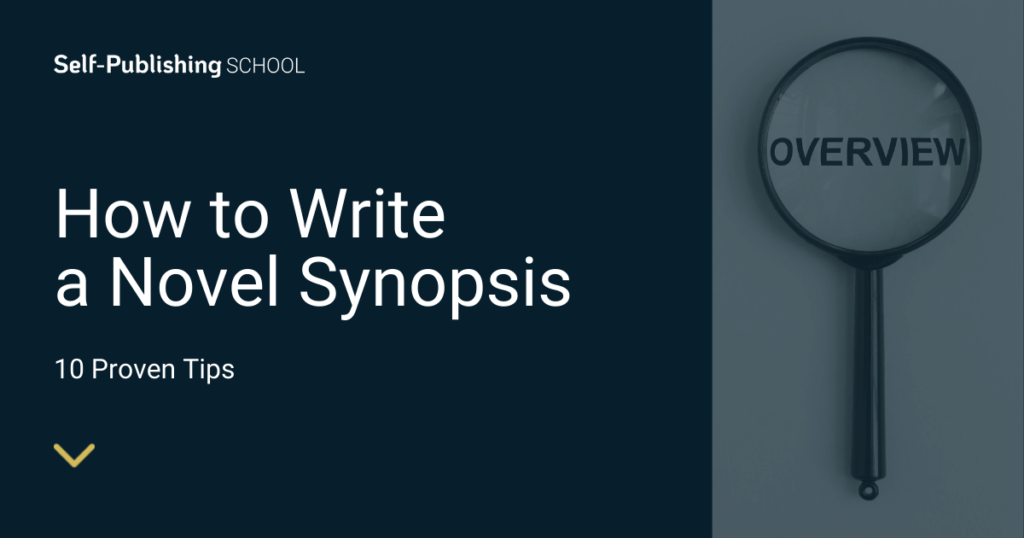In the entrepreneurship sphere, there’s a sentiment that if you can’t pitch your business idea in two sentences, it’s probably a bad idea.
In the writing world, that concept applies to the book synopsis. If you can’t sell your book in one page, it might not be a good idea.
So how do you write a killer synopsis? What is even supposed to go into one?
In this article, we’ll cover how to write a novel synopsis, as well as:
- What is a novel synopsis?
- Why are synopses important?
- What to include in a book synopses?
- How to write a novel synopsis
- Book synopsis template
What is a novel synopsis?
A novel synopsis is a short summary of your story’s main elements like plot, subplots, the ending, your main character arcs, and other fundamental pieces of the story. Since the synopsis is meant to be short, it’s often impossible to include every subplot, so the standard practice is to only include subplots that are directly relevant to the main plot. Likewise, the only supporting characters included have to be necessary to understand the main character’s arc. Any other subplots or characters should likely be excluded from the synopsis.
Along with being short, a synopsis is, ideally, interesting to read and portrays your writing style without being too flowery or self-indulgent.
Synopses are most often used in agent pitch letters, so potential agents can get a quick understanding of what your book is about. Many agents don’t even read them, but authors still have to write one. Preferably an amazing one.
You’ve likely heard lots of tips and advice about writing your novel synopsis, and you’ve probably noticed a lot of conflicting ideas. That’s because they’re tricky to write! Let’s look at a few strategies you might consider to make sure your synopsis is as strong as it can be.

Why are synopses important?
Synopses are an important piece of book proposals and query letters, which authors use when pitching literary agents and publishers. Even self-published authors might use book synopses to send to potential reviewers, distributors, and other players in the book industry. Whether you go with traditional or self-publishing, a book synopsis can help you get crystal clear on your idea.
Writing a synopsis before you finish your final (or first) draft can also help you to spot major errors in the story. (A story outline can also help with this.) It will help you see if the character arcs make sense, if the motivation is there, and if one action point leads into the next in a logical way.
Some agents might not even read the synopsis, but the ones who do are looking for something energetic and engaging. Use crisp prose, and make your synopsis as compelling as possible. Sell your book!
What to include in a book synopsis?
Okay, we’ve decided we need to write a synopsis–but what do we include?
1. Character. Most synopses will begin with the protagonist, explaining her motivation and situation at the beginning of the story, then revealing what happens to change her situation. You might introduce just the protagonist, the protagonist and antagonist, or another combination of characters. The best way to decide who to include is to ask yourself which characters are absolutely necessary to mention to explain the main character’s arc.
- Related: Redemption Arc
- Related: Flat Character Arc
2. Narrative arc. Next, we see the story itself. Cause and effect explanations, the driving conflict, significant scenes. Tell us the rising actions in a few paragraphs. Just like with character inclusion, only will ideally only include subplots that are completely necessary for the context of the main plot.
3. Conflict resolution. In the end, we need to see how the story ends, how the conflict is resolved, and where our protagonist ended up, i.e., how they’ve internally and externally changed by the end of the story.
4. Defining traits. Your synopsis should include the genres your book falls into. It might be relevant to note your target demographic as well, especially if you’re pitching a children’s book.
You’ll see conflicting advice on whether or not to include themes and other details, but a good rule of thumb is that you should exclude those if they don’t add to the pitch. If the themes are obvious by the summary of the book, or if they’re pretty run-of-the-mill, you’re probably good to leave them out. If you have a particularly unique theme, it’s likely in your best interest to mention it in the synopsis.
Even if you’re keeping the synopsis short and to the point, you probably won’t have room for many subplots. Keep to the core story, because there’s often no room or time to explain every bit of the book.
If you’re not sure what should stay and what should go, ask yourself: Does the ending make sense without this element included? If the answer is yes, you can probably cut it.
How to write a novel synopsis
Here are some tips to keep in mind when you’re putting the book synopsis together:
1. Use third person present tense.
Even if your book is written in a different tense or point of view, a fiction book synopsis is standardly written in third person present tense. In rare and weird cases, an agent might request a different format, so keep that in mind for any tips you see on writing synopses. There are standard practices and great bits of advice on it, but the agent’s preferences should always trump the way you put your application together, over any other advice.
Note: Memoirs are typically written in first person past tense.
2. Keep it short.
You’ll find a wide range of recommendations for the length of your synopsis, but it’s a good practice to have one under 1,000 words to have as a default, then lengthen it or shorten it based on the specific requests of the agent you’re submitting to.
Eventually, you may need a longer synopsis that averages one page of summary per each 25-30 pages of manuscript. Some agents will request this, but not before they’ve read and loved the shorter version.
3. Don’t avoid spoilers.
The synopsis isn’t a piece of marketing to readers. Don’t be afraid to include spoilers in your book synopsis, because your agents want to know what happens. You should provide an exact summary of the major plot points, the character’s arc, and the ending of the story. It’s impossible to do that without spoilers, so keep in mind that the spoilers are supposed to be there.
4. Include your voice and style, but don’t overdo it.
You want your synopsis to demonstrate your writing skills, but don’t get too poetic with your descriptions. It’s fine to “tell” in the synopsis, and you’ve gotta keep it short.
Ideally, your book synopsis should read like a story itself. Pay attention to the flow of the entire piece, put some effort into your opening hook, and write it as compellingly as you can. Entertain the reader.
5. Name the genre.
Don’t be coy or withholding–explain your book! Name the genres, the themes, use comparative media if it feels appropriate for the application. Don’t leave it up to the agent to figure out where your book would fit on a store shelf. Tell them!
6. Don’t make it a listicle.
Write your synopsis in a way that flows and tells a story. Simply listing facts about your book probably won’t hold anyone’s interest through the whole synopsis.
7. Include emotions.
Let us know what your character feels during those plot beats. How are they changing? Where does it leave them?
8. Don’t get caught up on the details.
A common mistake in book synopsis is when the writer gets too caught up in the minutiae of the book. Just hit the beats that matter, and try not to get lost in details. Here’s an example to illustrate—
Too detailed: Sara enters the coffee shop while it’s late and raining, so she’s cranky. After she orders a drink, a man enters and tries to start up a conversation. When she snaps at him, he leaves the shop.
To-the-point: Sara clashes with a stranger as soon as she arrives.
9. Clean him up!
Your synopsis should be professional, formatted, and error-free. Double-space the document, use proper indentation, and make sure you’ve thoroughly proofread the copy. Send it around to friends and colleagues for a second opinion before you start sending it out to agents.
10. Write a great pitch line.
Your pitch line should be at the beginning of the synopsis. It’s the hook, for both the book and the synopsis. It should be interesting, clever, and intriguing. Your pitch line might be a snappy summary of the key dilemma in your novel. Some writers will use a choice quote from the book as their pitch line. If you are using a quote, it’s best not to include too many, if any, quotes from the book in the rest of your synopsis. You also shouldn’t have an opening quote AND a statement of the key dilemma or question of the novel–just using one of those options is plenty.
Since this is the first introduction to your synopsis and book, make sure you really apply some time and effort to honing a great pitch line. This is likely a piece you’ll use in other materials as you sell your book, so it’s not a waste of time to do it right.
Book synopsis template
If you need a little more help with how to write a novel synopsis, here’s a simple template to start you out.
TITLE (even if it’s a working title)
Paragraph one:
- Name your genre, if you know it. You might also name the age group you’re writing for.
- Pitch line–what is the key dilemma in your novel? What is the heart of the story? Your pitch line is the introduction and hook for your synopsis, so put some effort in here.
- Introduce the main character. The protagonist and, if relevant, the antagonist.
- Include their headspace and motivation, where they are when the story starts, when the story is happening, and the inciting incident.
Paragraph two:
- What is your protagonist going to do now? What is the antagonist doing?
- Include the major plot points of the story
- Only include additional characters and subplots if it is impossible not to.
Paragraph three:
- How does it end? Don’t avoid spoilers here–tell us how the plot wraps up, where our characters ended up, and how they’ve changed.
Writing a book synopsis can be pretty intimidating, but going into it with an idea of your goals and how you’d like the end result to look can help you get started. Keep it clean, short, and entertaining. While you should be careful to follow any instructions that individual agents ask for, it’s helpful to have a default synopsis to edit and personalize for each application.
If you’re ready to write your novel, check out this article and the free training below:
